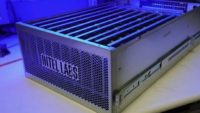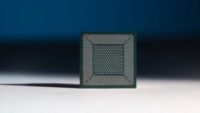Intel to Unveil Experimental Neuromorphic Computing System
March 20, 2020
Intel will debut Pohoiki Springs, an experimental research system for neuromorphic computing that simulates the way human brains work and computes more quickly and with less energy. It will first be made available, via the cloud, to the Intel Neuromorphic Research Community, which includes about a dozen companies (such as Accenture and Airbus), academic researchers and government labs. Intel and Cornell University jointly published a paper on the Loihi chip’s ability to learn and recognize 10 hazardous materials from smell.
The Wall Street Journal reports that, according to Gartner, “neuromorphic chips are expected to be the predominant computing architecture for new, advanced forms of artificial-intelligence deployments by 2025,” when it is “expected to displace graphics processing units, one of the main computer chips used for AI systems, especially neural networks.”

Neuromorphic computing will make it possible to “train machine-learning models using a fraction of the data it takes to train them on traditional computing hardware.” Intel’s Neuromorphic Computing Lab director Mike Davies noted that the models “learn similarly to the way human babies learn, by seeing an image or toy once and being able to recognize it forever … [and] can also learn from the data, nearly instantaneously, ultimately making predictions that could be more accurate than those made by traditional machine-learning models.”
The practical use of neuromorphic computing could be to “automatically help identify certain areas where power will be needed most” in the case of a power outage or “help consumers more accurately find items that are similar to or match photos of specific products.” Davies added that, “unlike in traditional machines, in the Pohoiki Springs system, the memory and computing elements are intertwined rather than separate … [which] minimizes the distance that data has to travel.”
In a recent test, Intel “used a single neuromorphic research chip to train an AI system to recognize hazardous odors using one training sample per odor, compared to the 3,000 samples required in state-of-the-art deep-learning methods.”

The Pohoiki Springs system is comprised of “about 770 such neuromorphic research chips inside a chassis the size of five standard servers.” Accenture Labs chief research scientist Edy Liongosari reported that his company “has been working with Intel’s neuromorphic computing researchers since 2018 to see how the technology could benefit AI algorithms that are used in Internet-connected devices, such as security cameras that are constantly detecting motion,” using significantly less energy.
VentureBeat reports that Intel and Cornell University jointly published a paper on the system’s ability to “learn and recognize 10 hazardous materials from smell — even in the presence of ‘significant’ data noise and occlusion.” Published in Nature Machine Intelligence, the researchers describe how the test drew “from a data set consisting of the activity of 72 chemical sensors in response to various smells.”
Intel neuromorphic computing lab senior research scientist Nabil Imam stated his belief that neuromorphic systems will be able to “diagnose diseases, detect weapons and explosives, find narcotics, and spot signs of smoke and carbon monoxide.” “Researchers at Intel, IBM, HP, MIT, Purdue, Stanford … hope to leverage it to develop a supercomputer a thousand times more powerful than any today.”

No Comments Yet
You can be the first to comment!
Sorry, comments for this entry are closed at this time.